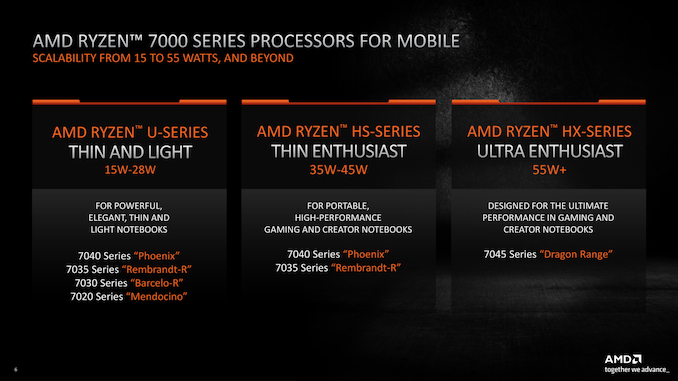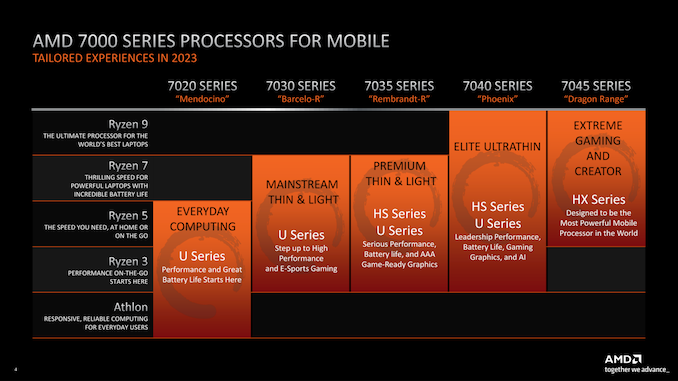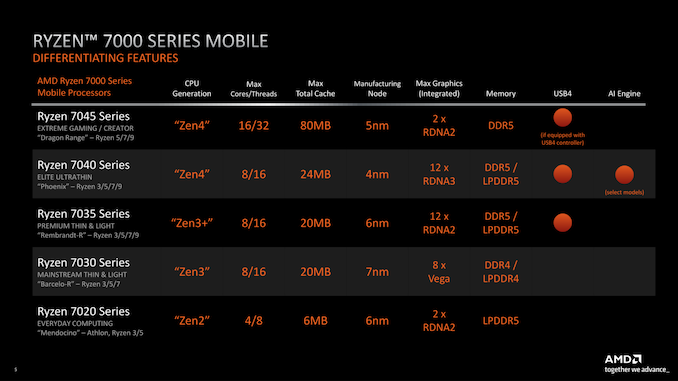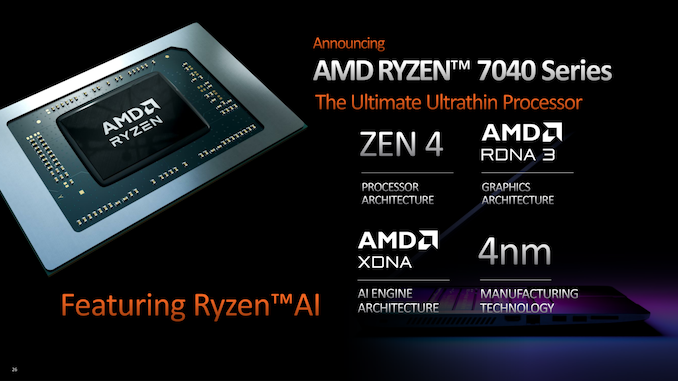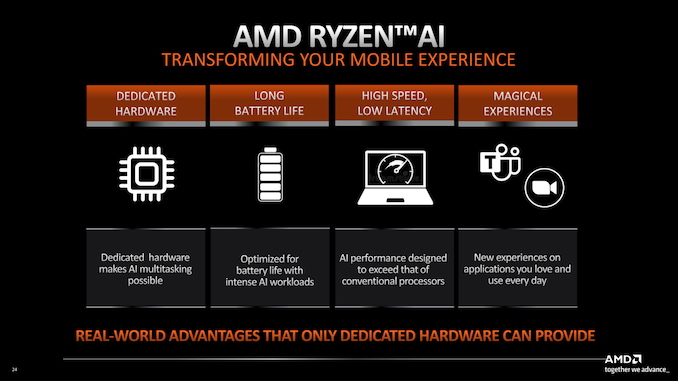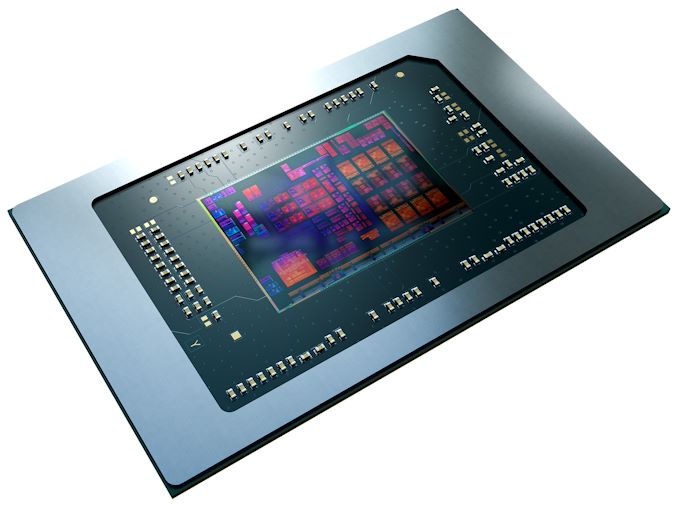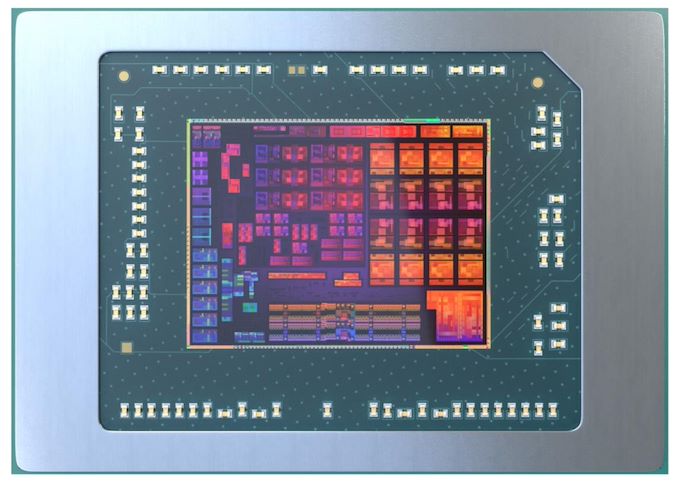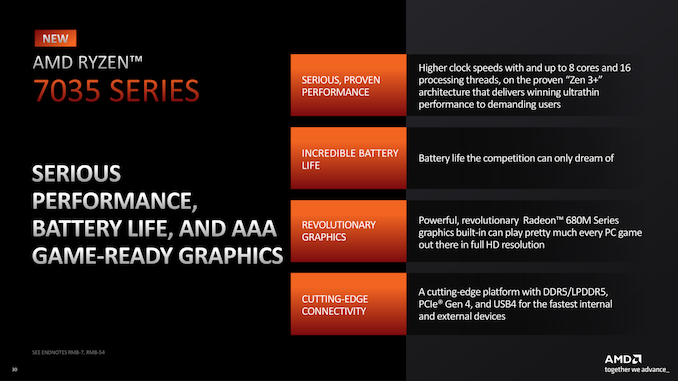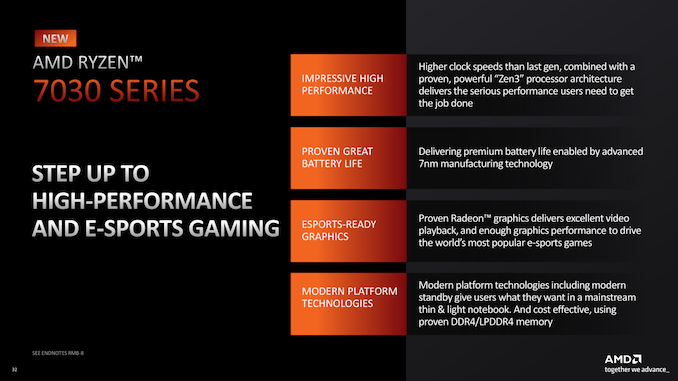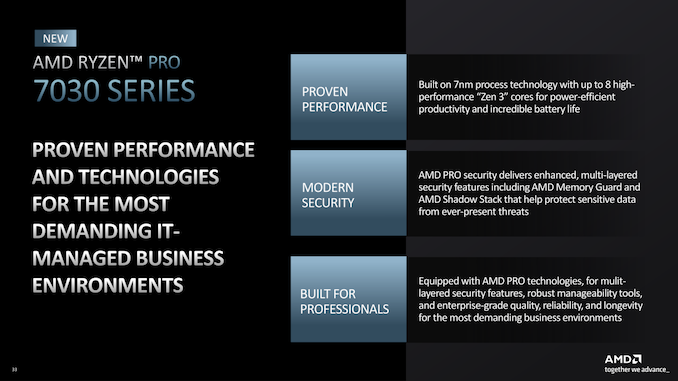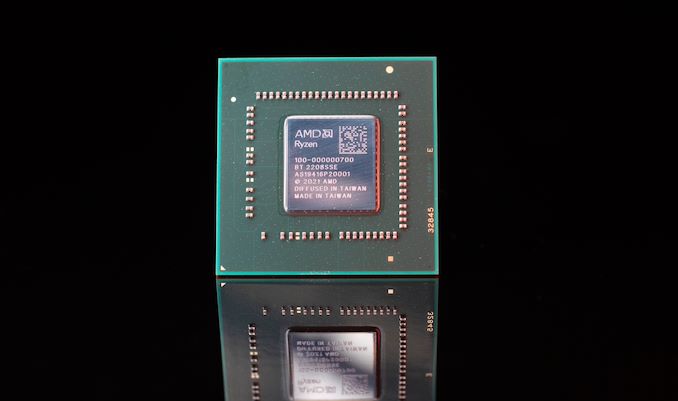
Original Link: https://www.anandtech.com/show/18718/amd-2023-ryzen-mobile-7000-cpus-unveiled-zen-4-phoenix-takes-point
AMD Lays Out 2023 Ryzen Mobile 7000 CPUs: Top-to-Bottom Updates, New Zen 4 'Phoenix' CPU Takes Point
by Ryan Smith on January 4, 2023 10:30 PM EST
This year’s CES has turned out to be a laptop-centric event in the PC space, and no farther do you have to look for proof of that than AMD’s CES keynote. The densely packed keynote immediately kicked things off with the announcement of AMD’s 2023 mobile product stack, which will see the CPU vendor mixing and matching silicon across multiple generations of designs to put together a fresh product stack for the new year. This includes the return of some old favorites, including bringing desktop Zen 4 silicon to mobile, as well as the introduction of AMD’s brand-new Phoenix CPU silicon, their first mobile-focused Zen 4 CPU design. There’s a lot to unpack here, so let’s dive right in.
New Names, New Categories, Mobile Silicon Smorgasbord
First and foremost, this year marks the kick-off point for AMD’s new mobile CPU naming system. First unveiled by the company back in September, AMD is moving to a model year system, incrementing the first digit of their processor model numbers each and every year. In practice, AMD has committed themselves to offering a mix of new silicon and product refreshes (e.g. new or rebadged SKUs) every year. Given AMD’s affinity for announcing new mobile CPUs at CES, I suspect this means we’re going to be talking about a new top-to-bottom AMD mobile CPU product stack at each and every CES from now on.
| AMD Ryzen Mobile Product Number Decoder (2023- 2025) | ||
| AnandTech | Signifies | Values |
| First Digit | Model Year | 7 = 2023 8 = 2024 9 = 2025 |
| Second Digit | Major Market Segment | 1 = Athlon Silver 2 = Athlon Gold 3 & 4 = Ryzen 3 5 & 6 = Ryzen 5 7 = Ryzen 7 8 = Ryzen 7 or Ryzen 9 9 = Ryzen 9 |
| Third Digit | CPU Architecture | 1 = Zen/Zen+ 2 = Zen 2 3 = Zen 3 4 = Zen 4 5 = Zen 5 |
| Fourth Digit | Feature Isolation / Minor Performance Segment |
0 = Lower Segment 5 = Higher Segment |
| Suffix | TDP/Form Factor | HX = 55W+ HS = 35W - 54W U = 15 - 28W e = 9W C = Chromebook (15 - 28W) |
If you only take away two things from AMD’s new product naming system, the important things are that the leading digit is the model year, and the third digit is the CPU architecture (e.g. Zen 4). The rest, while still important, are there to define segments and TDPs, rather than the hardware itself.
As part of this product name refactoring, AMD has also revised their TDP classes for mobile CPUs. Starting with the Ryzen Mobile 7000 series, the H-series class has been retired. Instead, the HS-series now covers the 35W to 45W via configurable TDPs, making the separate H and HS series redundant in AMD’s eyes. In practice we’ve seen AMD goose their H(S) silicon over 45W in the past, and I wouldn’t consider that to be off the table in the future, but for now those are the official ranges.
For anyone that needs a more powerful (and power-hungry) CPU still, there is the HX class. Which in this generation has gone from being a high TDP variant of AMD’s mobile silicon, and instead is using AMD’s desktop silicon, similar to what Intel does with their own HX series processors. Gavin has a great write-up on the new HX mobile SKUs in another piece, but in short, the 7045 series Dragon Range platform is the mobile variant of AMD’s desktop Ryzen 7000 “Raphael” silicon, chiplets and all.
For everything else, AMD is offering a mix of mobile-focused monolithic CPU dies across the rest of the Ryzen Mobile 7000 series family, including the new 7040 series Phoenix platform.
The lineup ends up looking like the above, with Dragon Range being dedicated to DTR-class laptops. Meanwhile AMD’s more portable laptops will use Phoenix for the fastest and most expensive laptops, with the refreshed Zen 3-based Rembrandt-R (7035 series) and Barcelo-R (7030 series) platforms providing for cheaper options, particularly with the 15-28 Watt U-series parts. Finally, AMD’s Zen 2 Mendocino platform, which was introduced towards the end of last year and is already part of the Ryzen Mobile 7000 family, will remain as their budget offering for thin and light laptops.
And here’s what that looks like in terms of hardware features/specifications:
The end result is that between their various sub-series, the Ryzen Mobile 7000 family is comprised of a mix of 3 different Zen CPU architectures, built across 4 different process nodes. It is, for better or worse, a very dense mobile product stack, with 19 different consumer SKUs and another 3 PRO SKUs, covering a significant range of features and performance levels, as well as price ranges. So between all of these configurations, AMD should have something for everyone in their 2023 mobile CPU product stack.
Ryzen Mobile 7040 Series: Zen 4 Phoenix Takes Flight
The only truly new silicon among today’s announcements, and arguably the marquee announcement among this evening’s mobile announcements, is AMD’s Ryzen Mobile 7040 series of chips. Codenamed Phoenix, this is AMD’s first mobile-centric Zen 4 CPU design, incorporating the new CPU cores, new RDNA 3 iGPU, and more into a new monolithic silicon die. AMD initially teased Phoenix back at their 2022 Financial Analyst Day, so while this evening’s announcement was hardly out of the blue, it’s been an eagerly anticipated one, as the Zen 4 CPU architecture was designed to shine in mobile just as much as it does the desktop.
Phoenix is AMD’s flagship mobile silicon, and the successor to the Zen3+/RDNA2 Rembrandt, which was the basis of the Ryzen Mobile 6000 series. Iterating on top of that design, Phoenix incorporates up to 8 of AMD’s new Zen 4 CPU cores, as well as a high-performance integrated GPU based on AMD’s new RDNA 3 architecture, with up to 12 CUs.
All of this, in turn, is being built on TSMC’s 4nm process, which makes it the single most advanced piece of silicon out of AMD yet, eclipsing even the 5nm-based Ryzen 7000 and Radeon RX 7000 families. Which is not to oversell 4nm here – TMSC’s 4nm nodes are all variants of their 5nm process, and we don’t know which specific variant AMD is using here – but it underscores that AMD has spared no expense here by using the best (and most expensive) process node they could get their hands on for their next generation mobile CPU.
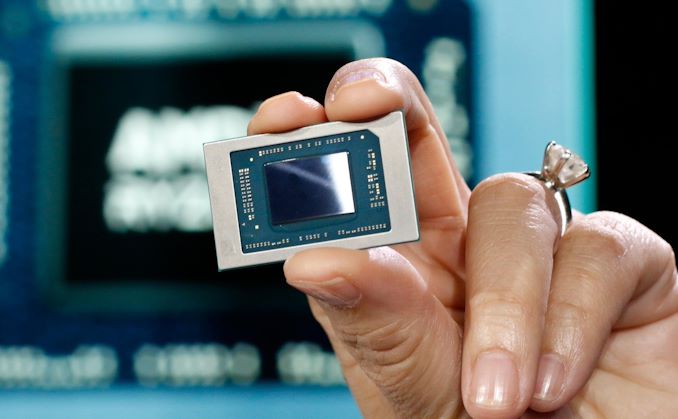
Phoenix in the silicon flesh (Image Courtesy AMD)
Along with the new CPU and GPU architectures, Phoenix also marks one more first for an AMD processor: it is the first AMD CPU to incorporate an AI engine/neural networking processor.
Adopting their Xilinx-developed XDNA architecture, AMD has placed an XDNA processing block, which they’ve dubbed Ryzen AI, on Phoenix to accelerate the processing of AI workloads. As with other dedicated silicon blocks/domain specific accelerators, the inclusion of an AI engine is both to offer better throughput on a specific task, and to also execute that task in a far more power efficient manner. This, as AMD reasons, will give them an edge in performance, along with energy efficiency in tasks that can leverage the Ryzen AI block.
At this point AMD isn’t quoting performance figures for the AI engine, so we don’t have any hard numbers to use in comparison. But AMD has told us that the block can process up to 4 streams of AI workloads, and that it’s 20% faster than the neural engine on Apple’s M2 SoC. Obviously, any Apple comparisons are going to raise a few eyebrows as they’re the player to beat in the laptop space right now, so it will be interesting to see how these claims pan out once Phoenix starts shipping.
In any case, the Apple comparison is apt, as AMD is clearly taking a page from the mobile (handset) market playbook with the inclusion of a neural network processor. These AI processors have proven highly effective in mobile devices, and with Moore’s Law slowing down, the tech industry as a whole is drifting towards using more DSAs to keep performance and performance efficiency growing. So for a while now, it’s been clear that it would only be a matter of time; and in 2023, AMD is in a great position to do so thanks to their Xilinx acquisition.
With that said, this is clearly the very early days for an AI engine on a PC (Windows) laptop. The software ecosystem to make use of the hardware is not yet in place – especially in the consumer space – so AMD is taking the first step by providing hardware for developers to start coding against. AMD considers the Ryzen AI engine to be a long-term investment, and we should expect to see it appear in more AMD products over the coming years, as well as receiving hardware upgrades of its own. In the meantime, it’s going to be more of a conversational feature until consumer software is ready.
Moving on, AMD is initially launching 3 SKUs based on Phoenix, which per the new naming system, are all part of the Ryzen Mobile 7040 series. These are all HS-series parts, meaning they have TDPs of 35W to 45W, and while the 7040 series is slated to eventually come in U-series parts as well, AMD is going to be pushing their first Phoenix chips into the most visible (and profitable) segment of the notebook market.
| AMD Ryzen 7040 Mobile CPUs 'Phoenix' on 4nm |
|||||||
| AnandTech | C/T | Base Freq |
Turbo Freq |
GPU | GPU Freq | L3 Cache (MB) |
TDP |
| HS-Series 35W - 54W | |||||||
| Ryzen 9 7940HS | 8/16 | 4000 | 5200 | RDNA 3 12 CUs |
3000 | 16 | 35W - 54W |
| Ryzen 7 7840HS | 8/16 | 3800 | 5100 | RDNA 3 12 CUs |
2900 | 16 | 35W - 54W |
| Ryzen 5 7640HS | 6/12 | 4300 | 5000 | RDNA 3 8 CUs |
2800 | 16 | 35W - 54W |
For the 7040 launch, there is an SKU each for the Ryzen 9, Ryzen 7, and Ryzen 5 segments. The Ryzen 9 7940HS and Ryzen 7 7840HS have all 8 CPU cores enabled, and differ only in terms of their clockspeeds. Meanwhile the Ryzen 5 part, the 7640HS, drops down to 6 CPU cores, and we’re still waiting to hear from AMD about how many RDNA 3 CUs are enabled (R5 parts typically have a half-enabled GPU).
At the high end, the 7940HS will be able to turbo as high as 5.2GHz, which is 200MHz higher than the fastest Ryzen Mobile 6000 chip. So the 7040 series will be enjoying both slightly higher CPU clockspeeds and a higher IPC rate than their predecessors. This does end up being a bit lower than the clockspeeds on the desktop-derived HX series parts, which go as high as 5.4GHz, which is part of the reason why AMD is offering the HX series as well – for buyers who need the very highest in CPU performance.
Notably, the 7040 series supports DDR5-5600 memory along with LPDDR5x-7500. Given that the HX series exists for peak performance needs, it’s somewhat difficult to imagine laptop vendors going with DDR5 on 7040 series laptops given the power efficiency hit. But the option is there, especially if they need to be able to offer removable DIMMs.
With regards to performance expectations, AMD is not offered us much in the way of useful comparisons (at least not in advance). So it’s not clear just how much faster these parts are going to be in CPU or GPU workloads compared to the existing Ryzen 6000 (Rembrandt) parts. AMD tells us that they do expect to compare favorably to Intel, who also announced new mobile parts this week. However unlike AMD, Intel doesn’t have a new CPU architecture or process node to take advantage of for this generation, so Intel’s position in the 45W market is fairly stagnant. That means the 7040 series gives AMD an opportunity to move ahead of Intel’s Alder Lake-derived parts, both from the 12th and 13th Core generations. If ever there was a time AMD was going to clearly and convincingly beat Intel in the 45W segment, this is it.
AMD has told us that the new Ryzen Mobile 7040 parts will also offer battery life improvements over their earlier parts (and Intel’s, as well). But AMD is not offering any specific performance figures here. So we’ll have to see how things shake out once 7040 series laptops start shipping.
And shipping dates are the one downbeat piece of news this evening; the first 7040 laptops won’t be shipping until March, a couple of months down the line. And we would be remiss to not point out that AMD’s mobile CPU shipment dates tend to be overly optimistic to begin with – often it’s a couple of months later before you can find laptops based on new AMD silicon in volume. So while we hope that AMD has some of the kinks worked out on their mobile product pipeline, there’s a genuine risk that 7040 series laptops may not be readily available until later in the spring.
Looking farther down the line, 7040/Phoenix is also slated to become available in 15 – 28 Watt U-series SKUs at some point. AMD has not offered any timeline for this, but it’s something for AMD laptop aficionados to look forward to later on in 2023.
Ryzen Mobile 7035 Series: Rembrandt Rides Again For HS and U
Moving down AMD’s stack, the next tier down of mobile CPUs is the Ryzen Mobile 7035 Series. This is based on AMD’s existing Rembrandt silicon, which was the basis of the Ryzen Mobile 6000 series. This was AMD’s second-generation Zen 3 mobile CPU, combining their power-optimized Zen3+ CPU architecture with the then-new RDNA 2 GPU architecture, and built on TMSC’s 6nm process. Rembrandt is still a potent design coming into 2023, but obviously it will be outshone by Phoenix once the 7040 series starts shipping.
| AMD Ryzen 7035 Mobile CPUs 'Rembrandt-R' on 6nm |
|||||||
| AnandTech | C/T | Base Freq |
Turbo Freq |
GPU | GPU Freq | L3 Cache (MB) |
TDP |
| HS-Series 35W - 45W | |||||||
| Ryzen 7 7735HS | 8/16 | 3200 | 4750 | RDNA 2 12 CUs |
2200 | 16 | 35W |
| Ryzen 5 7535HS | 6/12 | 3300 | 4550 | RDNA 2 6 CUs |
1900 | 16 | 35W |
| U-Series 15W - 28W | |||||||
| Ryzen 7 7735U | 8/16 | 2700 | 4750 | RDNA 2 12 CUs |
2200 | 16 | 15 - 28W |
| Ryzen 5 7535U | 6/12 | 2900 | 4550 | RDNA 2 6 CUs |
2200 | 16 | 15 - 28W |
| Ryzen 3 7335U | 4/8 | 3000 | 4300 | RDNA 2 4 CUs |
1900 | 8 | 15 - 28W |
The refresh SKUs for 2023, which are being called Rembrandt-R, are a mix of HS and U-series parts. The HS series parts are effectively a lower price, lower performance alternative to the “elite” 7040, with an 8 core Ryzen 7 (7735HS) and 6 core Ryzen 5 (7535HS) option. The rest of the lineup are U-series parts, as it will be the 7035 series that provides AMD’s top U-series SKUs for the time being. These include an 8 core Ryzen 7 (7735U), 6 core Ryzen 5 (7375U), and a 4 core Ryzen 3 (7335U). AMD did at one point have plans for a Ryzen 9 SKU as well, as outlined in September, but this has since been dropped.
All of these parts are quite similar to their predecessors. Narrowly avoiding being an outright rebadge, all of these parts see their max turbo clockspeeds goosed by 50MHz compared to their 6000 series counterparts, putting the Ryzen 9 7735HS and 7735U at the top with peak turbo clockspeeds of 4.75GHz.
There’s little to be said about 7035/Rembrandt that we haven’t already said back in last year’s Rembrandt (6900HS) review. It’s well-designed silicon, and especially with Intel’s mobile product stack being largely stagnant, the competitive landscape between the two chipmakers isn’t changing much for either side at this segment. Though that will only remain the case until the 7040 series eventually trickles down to lower TDPs.
Ryzen Mobile 7030 Series: Barcelo Is Back For Round 3
Bringing up the rear of AMD’s traditional Ryzen Mobile CPU stack for the 7000 series, we have the Ryzen Mobile 7030 series, codenamed Barcelo-R. Introduced in 2022, Barcelo itself was a rebadge of an earlier AMD silicon design, Cezanne, which was launched as the basis of the Ryzen Mobile 5000 series in 2021. This was AMD’s first Zen 3 mobile CPU design, which combines Zen 3 CPU cores with a Vega integrated GPU, and is built on TSMC’s 7nm process.
| AMD Ryzen 7030 Mobile CPUs 'Barcelo-R' on 7nm |
|||||||
| AnandTech | C/T | Base Freq |
Turbo Freq |
GPU | GPU Freq | L3 Cache (MB) |
TDP |
| U-Series 15W - 28W | |||||||
| Ryzen 7 7730U | 8/16 | 2000 | 4500 | Vega 8 CUs |
2000 | 16 | 15W |
| Ryzen 5 7530U | 6/12 | 2000 | 4500 | Vega 7 CUs |
2000 | 16 | 15W |
| Ryzen 3 7330U | 4/8 | 2300 | 4300 | Vega 6 CUs |
1800 | 8 | 15W |
This is, in short, being positioned at the budget option for a full fat Ryzen Mobile CPU. There are 3 SKUs here, which are all 15 Watt U-series parts. The top part is the Ryzen 7 7730U, which offers 8 CPU cores, followed by the Ryzen 5 7530U with 6 CPU cores. Curiously, the Ryzen 3 7330U is also listed with 6 CPU cores, despite the fact that the Ryzen 3 Barcelo part (5425U) was a 4 core part. So this may be a typo on AMD’s part. (Edit: And it is. The specs they have posted now are 4 cores)
In any case, the 7730U appears to be a direct rebadge of the 5825U, with the same core count and CPU clockspeeds. The 7530U is a new SKU, with a maximum turbo clockspeed of 4.5GHz that is higher than any previous Barcelo/Cezanne 6 core part. And of course, we’re not entirely sure whether the 7330U figures listed here are correct.
It’s a bit surprising to see AMD bringing out Barcelo/Cezanne for a third year, given that AMD’s Rembrandt is a mature platform at this point. But there’s no getting around the fact that anything made on TSMC’s 7nm process is going to be relatively cheap at this point, so this is likely to be a driving factor for AMD.
The Ryzen Mobile 7030 series will also be getting a trio of AMD Ryzen Pro Mobile counterparts, which are also being given 7030 series designations. This is the same Barcelo-R hardware, but with AMD’s PRO platform features enabled, along with their hardware and software stability promise. All of which means AMD is signing themselves up to keep the Barcelo/Cezanne platform available for another 2 years.
| AMD Ryzen Pro 7030 Mobile CPUs 'Barcelo-R' on 7nm |
||||||
| AnandTech | C/T | Base Freq |
Turbo Freq |
GPU | L3 Cache (MB) |
TDP |
| U-Series 15W - 28W | ||||||
| Ryzen 7 Pro 7730U | 8/16 | 2000 | 4500 | Vega 8 CUs |
16 | 15W |
| Ryzen 5 Pro 7530U | 6/12 | 2000 | 4500 | Vega 7 CUs |
16 | 15W |
| Ryzen 3 Pro 7330U | 6/12 | 2300 | 4300 | Vega 6 CUs? |
8 | 15W |
AMD has not announced an availability date for laptops based on the Ryzen Mobile 7035 or 7030 series. But as these are based on existing silicon, we’d expect to see laptops appear very shortly.
Ryzen Mobile 7020 Series: Mendocino Is Back To Basics
Last but not least, AMD’s existing Mendocino CPUs will continue to be the basis of the Ryzen Mobile 7020 series, serving as AMD’s entry-level silicon. Specifically fabbed as a entry-level part, Mendocino combines up to 4 Zen 2 CPU cores with a modest, 2 CU RDNA 2 GPU design (Radeon 610M) and is built on TSMC’s 6nm process. These chips are designed for mainstream notebooks in the $399 to $699 range.
| AMD Ryzen 7020 Mobile CPUs 'Mendocino' on 6nm |
||||||
| SKU | Cores/Threads | CPU Frequency (Base) |
CPU Frequency (1T Boost) |
Cache | iGPU | TDP |
| Ryzen 5 7520U | 4C / 8T | 2.8 GHz | 4.3 GHz | 2MB L2 + 4MB L3 | Radeon 610M | 15 W |
| Ryzen 3 7320U | 4C / 8T | 2.4 GHz | 4.1 GHz | 2MB L2 + 4MB L3 | Radeon 610M | 15 W |
| Athlon Gold 7220U | 2C / 4T | 2.4 GHz | 3.7 GHz | 1MB L2 + 4MB L3 | Radeon 610M | 15 W |
| Athlon Silver 7120U | 2C / 4T | 2.4 GHz | 3.5 GHz | 1MB L2 + 2MB L3 | Radeon 610M | 15 W |
AMD launched these parts back at the end of September, so there’s nothing new to report here regarding SKUs or capabilities. However now that the rest of the Ryzen Mobile 7000 family has finally come into focus, the 7020 series can finally take its place as AMD’s entry-level silicon.

